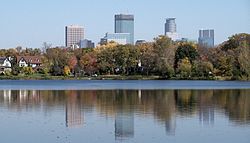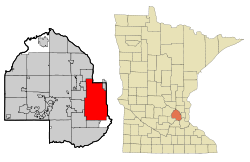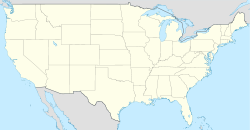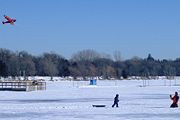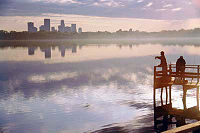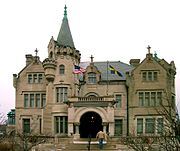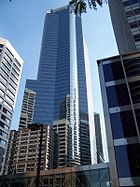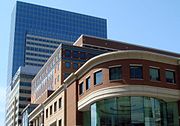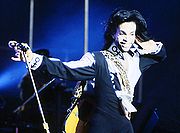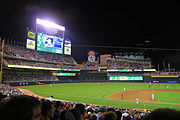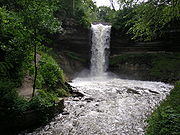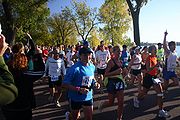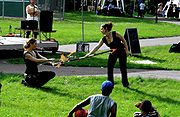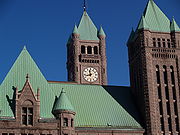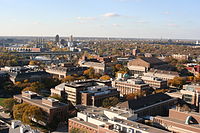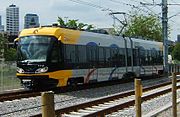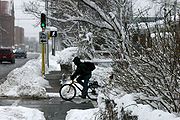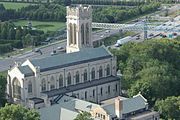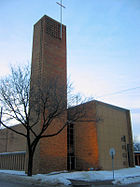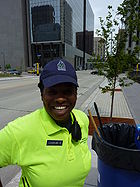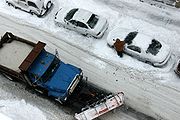
Minneapolis
Background Information
SOS Children produced this website for schools as well as this video website about Africa. SOS Child sponsorship is cool!
| Minneapolis | |||
|---|---|---|---|
| — City — | |||
 City of Minneapolis |
|||
| Downtown seen from Lake of the Isles | |||
|
|||
| Nickname(s): City of Lakes, Mill City, Twin Cities (with St. Paul) | |||
| Motto: En Avant (French: 'Forward') | |||
| Location in Hennepin County and the state of Minnesota | |||
|
|
|||
| Coordinates: 44°59′N 93°16′W Coordinates: 44°59′N 93°16′W | |||
| Country | United States | ||
| State | Minnesota | ||
| County | Hennepin | ||
| Incorporated | 1867 | ||
| Founder | John H. Stevens and Franklin Steele | ||
| Named for | Dakota word "mni" meaning water with Greek word "polis" for city | ||
| Government | |||
| • Mayor | R. T. Rybak ( DFL) | ||
| Area | |||
| • City | 58.4 sq mi (151.3 km2) | ||
| • Land | 54.9 sq mi (142.2 km2) | ||
| • Water | 3.5 sq mi (9.1 km2) | ||
| Elevation | 830 ft (264 m) | ||
| Population (2009) | |||
| • City | 385,378 (US: 48th) | ||
| • Density | 7,019.6/sq mi (2,710.1/km2) | ||
| • Metro | 3,269,814 ( 16th) | ||
| • Demonym | Minneapolitan | ||
| Time zone | CST ( UTC-6) | ||
| • Summer ( DST) | CDT ( UTC-5) | ||
| ZIP codes | 55401 – 55487 | ||
| Area code(s) | 612 | ||
| FIPS code | 27-43000 | ||
| GNIS feature ID | 0655030 | ||
| Website | www.MinneapolisMN.gov | ||
Minneapolis (pronounced /ˌmɪniːˈæpəlɪs/), nicknamed "City of Lakes" and the "Mill City," is the county seat of Hennepin County, the largest city in the U.S. state of Minnesota, and the 48th largest in the United States. Its name is attributed to the city's first schoolteacher, who combined mni, the Dakota word for water, and polis, the Greek word for city.
Minneapolis lies on both banks of the Mississippi River, just north of the river's confluence with the Minnesota River, and adjoins Saint Paul, the state's capital. Known as the "Twin Cities," Minneapolis-St. Paul is the 16th-largest metropolitan area in the U.S., with 3.5 million residents. The Metropolitan Council estimated the city's population in 2008 as 390,131.
The city is abundantly rich in water with over twenty lakes and wetlands, the Mississippi river, creeks and waterfalls, many connected by parkways in the Chain of Lakes and the Grand Rounds Scenic Byway. It was once the world's flour milling capital and a hub for timber, and today is the primary business center between Chicago and Seattle. Named America's most literate city, it has cultural organizations that draw creative people and audiences to the city for theatre, visual art, writing, and music. The community's diverse population has a long tradition of charitable support through progressive public social programs, as well as private and corporate philanthropy.
History
Dakota Sioux were the region's sole residents until French explorers arrived around 1680. Nearby Fort Snelling, built in 1819 by the United States Army, spurred growth in the area. The United States Government pressed the Mdewakanton band of the Dakota to sell their land, allowing people arriving from the east to settle there. The Minnesota Territorial Legislature authorized present day Minneapolis as a town on the Mississippi's west bank in 1856. Minneapolis incorporated as a city in 1867, the year rail service began between Minneapolis and Chicago. It later joined with the east bank city of St. Anthony in 1872.
Minneapolis grew up around Saint Anthony Falls, the highest waterfall on the Mississippi. Millers have used hydropower elsewhere since the 1st century B.C., but the results in Minneapolis between 1880 and 1930 were so remarkable the city has been described as "the greatest direct-drive waterpower centre the world has ever seen." In early years, forests in northern Minnesota were the source of a lumber industry that operated seventeen sawmills on power from the waterfall. By 1871, the west river bank had twenty-three businesses including flour mills, woolen mills, iron works, a railroad machine shop, and mills for cotton, paper, sashes, and planing wood. The farmers of the Great Plains grew grain that was shipped by rail to the city's thirty-four flour mills where Pillsbury and General Mills became processors. By 1905, Minneapolis delivered almost 10% of the country's flour and grist. At peak production, a single mill at Washburn-Crosby made enough flour for twelve million loaves of bread each day.
Minneapolis made dramatic changes to rectify discrimination as early as 1886 when Martha Ripley founded Maternity Hospital for both married and unmarried mothers. When the country's fortunes turned during the Great Depression, the violent Teamsters Strike of 1934 resulted in laws acknowledging workers' rights. A lifelong civil rights activist and union supporter, mayor Hubert Humphrey helped the city establish fair employment practices and a human relations council that interceded on behalf of minorities by 1946. Minneapolis contended with white supremacy, participated in desegregation and the African-American civil rights movement, and in 1968 was the birthplace of the American Indian Movement.
During the 1950s and 1960s, as part of urban renewal, the city razed about two hundred buildings across twenty-five city blocks—roughly 40% of downtown, destroying the Gateway District and many buildings with notable architecture including the Metropolitan Building. Efforts to save the building failed but are credited with jumpstarting interest in historic preservation in the state.
Geography and climate
The history and economic growth of Minneapolis are tied to water, the city's defining physical characteristic, which was sent to the region during the last ice age. Fed by receding glaciers and Lake Agassiz ten thousand years ago, torrents of water from a glacial river undercut the Mississippi and Minnehaha riverbeds, creating waterfalls important to modern Minneapolis. Lying on an artesian aquifer and otherwise flat terrain, Minneapolis has a total area of 58.4 square miles (151.3 km2) and of this 6% is water. Water is managed by watershed districts that correspond to the Mississippi and the city's three creeks. Twelve lakes, three large ponds, and five unnamed wetlands are within Minneapolis.
The city centre is located just south of 45° N latitude. The city's lowest elevation of 686 feet (209 m) is near where Minnehaha Creek meets the Mississippi River. The site of the Prospect Park Water Tower is often cited as the city's highest point and a placard in Deming Heights Park denotes the highest elevation, but a spot at 974 feet (297 m) in or near Waite Park in Northeast Minneapolis is corroborated by Google Earth as the highest ground.
Minneapolis has a continental climate typical of the Upper Midwest. Winters are cold and dry, while summer is hot and humid. On the Köppen climate classification, Minneapolis falls in the hot summer humid continental climate zone (Dfa) and has a USDA plant hardiness of zone 5a/4b. The city experiences a full range of precipitation and related weather events, including snow, sleet, ice, rain, thunderstorms, tornadoes, heatwaves, and fog. The warmest temperature ever recorded in Minneapolis was 108 °F (42 °C) in July 1936, and the coldest temperature ever recorded was −41 °F (−41 °C), in January 1888. The snowiest winter of record was 1983–84, when 98.4 inches (250 cm) of snow fell.
Because of its northerly location in the United States and lack of large enough bodies of water in close proximity to moderate the air, Minneapolis is sometimes subjected to cold Arctic air masses, especially during the months of January and February. The average annual temperature of 45.4 °F (7.4 °C) gives the Minneapolis–St. Paul metropolitan area the coldest annual mean temperature of any major metropolitan area in the continental United States.
| Climate data for Minneapolis/St. Paul | |||||||||||||
|---|---|---|---|---|---|---|---|---|---|---|---|---|---|
| Month | Jan | Feb | Mar | Apr | May | Jun | Jul | Aug | Sep | Oct | Nov | Dec | Year |
| Record high °F (°C) | 59 (15) |
64 (18) |
83 (28) |
95 (35) |
106 (41) |
104 (40) |
108 (42) |
103 (39) |
104 (40) |
90 (32) |
77 (25) |
68 (20) |
108 (42) |
| Average high °F (°C) | 23.7 (−4.6) |
28.8 (−1.8) |
41.3 (5.2) |
57.7 (14.3) |
69.4 (20.8) |
78.8 (26) |
83.4 (28.6) |
80.5 (26.9) |
71.7 (22.1) |
58.1 (14.5) |
41.2 (5.1) |
27.1 (−2.7) |
55.1 (12.8) |
| Average low °F (°C) | 7.4 (−13.7) |
12.7 (−10.7) |
24.2 (−4.3) |
37.2 (2.9) |
48.9 (9.4) |
58.7 (14.8) |
64 (17.8) |
61.7 (16.5) |
52.3 (11.3) |
39.6 (4.2) |
26.2 (−3.2) |
12.2 (−11) |
37.1 (2.8) |
| Record low °F (°C) | −41 (−41) |
−40 (−40) |
−32 (−36) |
2 (−17) |
18 (−8) |
34 (1) |
43 (6) |
39 (4) |
26 (−3) |
10 (−12) |
−25 (−32) |
−39 (−39) |
−41 (−41) |
| Precipitation inches (mm) | 0.9 (22.9) |
0.76 (19.3) |
1.89 (48) |
2.65 (67.3) |
3.36 (85.3) |
4.25 (108) |
4.04 (102.6) |
4.29 (109) |
3.07 (78) |
2.43 (61.7) |
1.76 (44.7) |
1.15 (29.2) |
30.55 (776) |
| Snowfall inches (cm) | 11.1 (28.2) |
7.7 (19.6) |
10.1 (25.7) |
2.3 (5.8) |
0 (0) |
0 (0) |
0 (0) |
0 (0) |
0 (0) |
0.6 (1.5) |
8.8 (22.4) |
10.2 (25.9) |
50.8 (129) |
| Avg. precipitation days (≥ 0.01 in) | 8.9 | 7.4 | 9.3 | 10.7 | 11.5 | 11.3 | 10.2 | 9.7 | 9.8 | 9.2 | 8.7 | 9.8 | 116.5 |
| Avg. snowy days (≥ 0.1 in) | 8.2 | 6.3 | 5.4 | 1.9 | 0.1 | 0 | 0 | 0 | 0 | 0.6 | 5 | 8.1 | 35.6 |
| Mean monthly sunshine hours | 158.1 | 180.8 | 217 | 243 | 294.5 | 321 | 350.3 | 306.9 | 234 | 179.8 | 114 | 114.7 | 2714.1 |
| Source #1: NOAA (1981−2010 normals) , The Weather Channel (Extremes) | |||||||||||||
| Source #2: HKO (sun only, 1961−1990) | |||||||||||||
Demographics
As of the 2006-2008 American Community Survey, the racial composition was as follows:
- White: 70.2% ( Non-Hispanic Whites: 64.2%)
- Black or African American: 17.4%
- American Indian: 1.7%
- Asian: 4.9%
- Native Hawaiian/ Pacific Islander: <0.1%
- Some other race: 2.8%
- Two or more races: 3.0%
- Hispanic or Latino (of any race): 9.2%
European Americans make up about two-thirds of Minneapolis's population. This community is predominantly of German and Scandinavian descent. There are 82,870 German Americans in the city, making up over one-fifth (23.1%) of the population. The Scandinavian American population is primarily Norwegian and Swedish. There are 39,103 Norwegian Americans, making up 10.9% of the population; there are 30,349 Swedish Americans, making up 8.5% of the city's population. Danish Americans aren't nearly as numerous; there are 4,434 Danish Americans, making up only 1.3% of the population. Norwegian, Swedish, and Danish Americans together make up 20.7% of the population. This means that Germans and Scandinavians together make up 43.8% of Minneapolis's population, and make up the majority of Minneapolis's non-Hispanic white population. Other significant European groups in the city include those of Irish (11.3%), English (7.0%), Polish (3.9%), French (3.5%) and Italian (2.3%) descent.
The American Community Survey estimated that there were 62,520 African Americans residing in Minneapolis, comprising over 17% of the city's population, compared to a statewide proportion of less than four percent.
The Hispanic and Latino population is predominantly Mexican. People of Mexican descent number at approximately 21,741, making up 6.1% of the city's population. There are 958 Puerto Ricans and 467 Cubans in Minneapolis, making up 0.3% and 0.1% of the population respectively. There are 10,008 Hispanics and Latinos (other than Mexicans, Puerto Ricans, and Cubans) of varying ancestries in the city; they collectively make up 2.8% of the population.
Minneapolis also has a sizable Asian community. There are approximately 17,686 Asian Americans in Minneapolis, making up just under 5% of the city's population. The Asian population is largely composed of Hmong Americans. Approximately 2,925 Chinese Americans reside in Minneapolis, making up 0.8% of the population. There are nearly 2,000 Indian Americans in the city, making up 0.6% of the population. Vietnamese Americans and Korean Americans make up 0.4% of the population each. People of Filipino and Japanese descent are few in Minneapolis. There are 603 Filipino Americans and 848 Japanese Americans in Minneapolis, making up roughly 0.2% of the populace each.
Minneapolis also has a sizable Native American community that is predominantly Chippewa. The Chippewa make up roughly 1.0% of the city's population. Of the 5,983 Native Americans, 3,709 are of the Chippewa tribe. In addition, there is a small Sioux community in Minneapolis; there are approximately 847 Sioux in the city, comprising 0.2% of the population.
There are 10,711 multiracial individuals in Minneapolis. People of black and white ancestry number at 3,551, and make up 1.0% of the population. People of white and Native American ancestry number at 2,319, and make up 0.6% of the population. Those of white and Asian ancestry number at 1,871, and make up 0.5% of the population. Lastly, people of black and Native American ancestry number at 885, and make up 0.2% of Minneapolis's population.
Dakota tribes, mostly the Mdewakanton, as early as the 16th century were known as permanent settlers near their sacred site of St. Anthony Falls. New settlers arrived during the 1850s and 1860s in Minneapolis from New England, New York, and Canada, and during the mid-1860s, immigrants from Finland and Scandinavians (from Sweden, Norway and Denmark) began to call the city home. Migrant workers from Mexico and Latin America also interspersed. Later, immigrants came from Germany, Italy, Greece, Poland, and Southern and Eastern Europe. These immigrants tended to settle in the Northeast neighbourhood, which still retains an ethnic flavor and is particularly known for its Polish community. Jews from Russia and Eastern Europe settled primarily on the north side of the city before moving in large numbers to the western suburbs in the 1950s and 1960s. Asians came from China, the Philippines, Japan, and Korea. Two groups came for a short while during U.S. government relocations: Japanese during the 1940s, and Native Americans during the 1950s. From 1970 onward, Asians arrived from Vietnam, Laos, Cambodia, and Thailand. Beginning in the 1990s, a large Latino population arrived, along with immigrants from the Horn of Africa, especially Somalia. The metropolitan area is an immigrant gateway which had a 127% increase in foreign-born residents between 1990 and 2000.
U.S. Census Bureau estimates in the year 2007 show the population of Minneapolis to be 377,392, a 1.4% drop since the 2000 census. The population grew until 1950 when the census peaked at 521,718, and then declined as people moved to the suburbs until about 1990. Among U.S. cities as of 2006, Minneapolis has the fourth-highest percentage of gay, lesbian, or bisexual people in the adult population, with 12.5% (behind San Francisco, and slightly behind both Seattle and Atlanta).
Racial and ethnic minorities lag behind white counterparts in education, with 15.0% of blacks and 13.0% of Hispanics holding bachelor's degrees compared to 42.0% of the white population. The standard of living is on the rise, with incomes among the highest in the Midwest, but median household income among minorities is below that of whites by over $17,000. Regionally, home ownership among minority residents is half that of whites though Asian home ownership has doubled. In 2000, the poverty rate for whites was 4.2%; for blacks it was 26.2%; for Asians, 19.1%; Native Americans, 23.2%; and Hispanics, 18.1%.
| U.S. Census Population Estimates | ||||||||||||||||
|---|---|---|---|---|---|---|---|---|---|---|---|---|---|---|---|---|
| Year | 1860 | 1870 | 1880 | 1890 | 1900 | 1910 | 1920 | 1930 | 1940 | 1950 | 1960 | 1970 | 1980 | 1990 | 2000 | 2009 |
| Population | 5,809 | 13,800 | 46,887 | 164,738 | 202,718 | 301,408 | 380,582 | 464,356 | 492,370 | 521,718 | 482,872 | 434,400 | 370,951 | 368,383 | 382,618 | 385,378 |
| U.S. Rank | — | — | 38 | 18 | 19 | 18 | 18 | 15 | 16 | 17 | 25 | 32 | 34 | 42 | 45 | 48 |
Economy
The economy of Minneapolis today is based in commerce, finance, rail and trucking services, health care, and industry. Smaller components are in publishing, milling, food processing, graphic arts, insurance, education, and high technology. Industry produces metal and automotive products, chemical and agricultural products, electronics, computers, precision medical instruments and devices, plastics, and machinery.
Five Fortune 500 headquarters are in Minneapolis proper: Target Corporation, U.S. Bancorp, Xcel Energy, Ameriprise Financial, and Thrivent Financial for Lutherans. Fortune 1000 companies in Minneapolis include PepsiAmericas, Valspar, Graco, and Donaldson Company. Apart from government, the city's largest employers are Target, Wells Fargo, Ameriprise, Star Tribune, U.S. Bancorp, Xcel Energy, IBM, Piper Jaffray, RBC Dain Rauscher, ING Group, and Qwest.
Foreign companies with U.S. offices in Minneapolis include Coloplast, RBC and ING Group.
Availability of Wi-Fi, transportation solutions, medical trials, university research and development expenditures, advanced degrees held by the work force, and energy conservation are so far above the national average that in 2005, Popular Science named Minneapolis the "Top Tech City" in the U.S. The Twin Cities ranked the country's second best city in a 2006 Kiplinger's poll of Smart Places to Live and Minneapolis was one of the Seven Cool Cities for young professionals.
The Twin Cities contribute 63.8% of the gross state product of Minnesota. The area's $145.8 billion gross metropolitan product and its per capita personal income rank fourteenth in the U.S. Recovering from the nation's recession in 2000, personal income grew 3.8% in 2005, though it was behind the national average of 5%. The city returned to peak employment during the fourth quarter of that year.
The Federal Reserve Bank of Minneapolis, serves Minnesota, Montana, North and South Dakota, and parts of Wisconsin and Michigan. The smallest of the twelve regional banks in the Federal Reserve System, it operates a nationwide payments system, oversees member banks and bank holding companies, and serves as a banker for the U.S. Treasury. The Minneapolis Grain Exchange founded in 1881 is still located near the riverfront and is the only exchange for hard red spring wheat futures and options.
Arts
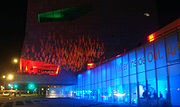
The region is second only to New York City in live theater per capita and is the third-largest theatre market in the U.S. after New York and Chicago, supporting the Illusion, Jungle, Mixed Blood, Penumbra, Mu Performing Arts, Bedlam Theatre, the Brave New Workshop, the Minnesota Dance Theatre, Red Eye, Skewed Visions, Theatre Latté Da, In the Heart of the Beast Puppet and Mask Theatre, Lundstrum Centre for the Performing Arts, and the Children's Theatre Company. The city is home to Minnesota Fringe Festival, the United States' largest nonjuried performing arts festival. French architect Jean Nouvel designed a new three stage complex for the Guthrie Theatre, a prototype alternative to Broadway founded in Minneapolis in 1963. Minneapolis purchased and renovated the Orpheum, State, and Pantages Theatres vaudeville and film houses on Hennepin Avenue now used for concerts and plays. Eventually, a fourth renovated theatre joined the Hennepin Centre for the Arts to become the Cowles Centre for Dance and the Performing Arts, to be completed in 2011 and a home to more than one dozen performing arts groups and a provider of Web-based art education.
The Minneapolis Institute of Arts, built in 1915 in south central Minneapolis is the largest art museum in the city with 100,000 pieces in its permanent collection. A new wing designed by Michael Graves was completed in 2006 for contemporary and modern works and more gallery space. The Walker Art Centre sits atop Lowry Hill, near downtown, and doubled its size with an addition in 2005 by Herzog & de Meuron and is continuing its expansion to 15 acres (6.1 ha) with a park designed by Michel Desvigne across the street from the Minneapolis Sculpture Garden. The Weisman Art Museum, designed by Frank Gehry for the University of Minnesota, opened in 1993. An addition, also designed by Gehry, is expected to open in 2011.
The son of a jazz musician and a singer, Prince is Minneapolis' most famous musical progeny. With fellow local musicians, many of whom recorded at Twin/Tone Records, he helped make First Avenue and the 7th Street Entry venues of choice for both artists and audiences. Other prominent artists from Minneapolis include Hüsker Dü and The Replacements, whose frontman Paul Westerberg went on to a successful solo career, who were pivotal in the alternative rock boom of the U.S. during the 1990s.
The Minnesota Orchestra plays classical and popular music at Orchestra Hall under music director Osmo Vänskä who has set about making it the best in the country—a critic writing for The New Yorker of a concert in 2010 thought that that day they were "the greatest orchestra in the world". In 2008, the century-old MacPhail Centre for Music opened a new facility designed by James Dayton.
Tom Waits released two songs about the city, Christmas Card from a Hooker in Minneapolis ( Blue Valentine 1978) and 9th & Hennepin ( Rain Dogs 1985) and Lucinda Williams recorded Minneapolis ( World Without Tears 2003). Home to the MN Spoken Word Association and independent hip-hop label Rhymesayers Entertainment, the city has garnered notice for rap and hip hop and its spoken word community. The underground hip-hop group Atmosphere (natives of Minnesota) frequently comments in song lyrics on the city and Minnesota.
Minneapolis and Seattle are tied as America's most literate city. A center for printing and publishing, Minneapolis was a natural place for artists to build Open Book, the largest literary and book arts centre in the U.S., made up of the Loft Literary Centre, the Minnesota Centre for Book Arts and Milkweed Editions, sometimes called the country's largest independent nonprofit literary publisher. The centre exhibits and teaches both contemporary art and traditional crafts of writing, papermaking, letterpress printing and bookbinding.
Sports
Professional sports are well-established in Minneapolis. First playing in 1884, the Minneapolis Millers baseball team produced the best won-lost record in their league at the time and contributed fifteen players to the Baseball Hall of Fame. During the 1940s and 1950s the Minneapolis Lakers basketball team, the city's first in the major leagues in any sport, won six basketball championships in three leagues to become the NBA's first dynasty before moving to Los Angeles. The American Wrestling Association, formerly the NWA Minneapolis Boxing & Wrestling Club, operated in Minneapolis from 1960 until the 1990s.
The Minnesota Vikings and the Minnesota Twins arrived in the state in 1961. The Vikings were an NFL expansion team and the Twins were formed when the Washington Senators relocated to Minnesota. Both teams played outdoors in the open air Metropolitan Stadium in the suburb of Bloomington for twenty one years before moving to the Hubert H. Humphrey Metrodome in 1982, where the Twins won the World Series in 1987 and 1991. The Twins moved to Target Field in 2010. The Minnesota Timberwolves brought NBA basketball back to Minneapolis in 1989, followed by the Minnesota Lynx WNBA team in 1999. They play in the Target Centre.
The downtown Metrodome, opened in 1982, is the largest sports stadium in Minnesota, with one major tenant, the Vikings. The Metrodome is the only stadium in the country to have hosted a Major League Baseball All-Star Game, the Super Bowl, the World Series, and NCAA Basketball Men's Final Four. Runners, walkers, inline skaters, coed volleyball teams, and touch football teams all have access to "The Dome". Events from sports to concerts, community activities, religious activities, and trade shows are held more than three hundred days per year, making the facility one of the most versatile stadiums in the world.
The state of Minnesota authorized replacement of the Metrodome with three separate stadiums that estimates in 2007 totaled at about $1.7 billion. Six spectator sport stadiums will be in a 1.2-mile (2 km) radius centered downtown, counting the existing facilities at Target Centre and the university's Williams Arena and Mariucci Arena. The new Target Field is funded by the Twins and 75% by Hennepin County sales tax, about $25 per year by each taxpayer. The Gopher football program's new TCF Bank Stadium was built by the university and the state's general fund. The Vikings Stadium plan for Blaine, Minnesota changed and as of 2007 was estimated at $954 million for rebuilding on the Metrodome site.
Major sporting events hosted by the city include Super Bowl XXVI, the 1992 NCAA Men's Division I Final Four, the 2001 NCAA Men's Division 1 Final Four and the 1998 World Figure Skating Championships.
Gifted amateur athletes have played in Minneapolis schools, notably starting in the 1920s and 1930s at Central, De La Salle, and Marshall high schools. Since the 1930s, the Golden Gophers have won national championships in baseball, boxing, football, golf, gymnastics, ice hockey, indoor and outdoor track, swimming, and wrestling.
| Professional Sports in Minneapolis | ||||
|---|---|---|---|---|
| Club | Sport | League | Venue | Championships |
| Minnesota Lynx | Basketball | Women's National Basketball Association, Western Conference | Target Centre | |
| Minnesota Timberwolves | Basketball | National Basketball Association, Western Conference, Northwest Division | Target Centre | |
| Minnesota Twins | Baseball | Major League Baseball, American League, Central Division | Target Field | World Series 1987 and 1991 |
| Minnesota Vikings | American Football | National Football League, National Football Conference, North Division | Metrodome | NFL Championship 1969 |
Parks and recreation
The Minneapolis park system has been called the best-designed, best-financed, and best-maintained in America. Foresight, donations and effort by community leaders enabled Horace Cleveland to create his finest landscape architecture, preserving geographical landmarks and linking them with boulevards and parkways. The city's Chain of Lakes, consisting of seven lakes and Minnehaha Creek, is connected by bike, running, and walking paths and used for swimming, fishing, picnics, boating, and ice skating. A parkway for cars, a bikeway for riders, and a walkway for pedestrians runs parallel along the 52 miles (84 km) route of the Grand Rounds Scenic Byway.
Theodore Wirth is credited with the development of the parks system. Today, 16.6% of the city is parks and there are 770 square feet (72 m2) of parkland for each resident, ranked in 2008 as the most parkland per resident within cities of similar population densities.
Parks are interlinked in many places and the Mississippi National River and Recreation Area connects regional parks and visitor centers. The country's oldest public wildflower garden, the Eloise Butler Wildflower Garden and Bird Sanctuary located within Theodore Wirth Park which is shared with Golden Valley and is about 60% the size of Central Park in New York City. Site of the 53-foot (16 m) Minnehaha Falls, Minnehaha Park is one of the city's oldest and most popular parks, receiving over 500,000 visitors each year. Henry Wadsworth Longfellow named Hiawatha's wife Minnehaha for the Minneapolis waterfall in The Song of Hiawatha, a bestselling and often-parodied 19th century poem.
Runner's World ranks the Twin Cities as America's sixth best city for runners. Team Ortho sponsors the Minneapolis Marathon, Half Marathon and 5K which began in 2008 with more than 1,500 starters. The Twin Cities Marathon run in Minneapolis and St. Paul every October draws 250,000 spectators. The 26.2-mile (42.2 km) race is a Boston and USA Olympic Trials qualifier. The organizers sponsor three more races: a Kids Marathon, a 1 mile (1.6 km), and a 10 miles (16 km).
In other sports, five golf courses are located within the city, with nationally ranked Hazeltine National Golf Club, and Interlachen Country Club in nearby suburbs. Minneapolis is home to more golfers per capita than any other major U.S. city. The state of Minnesota has the nation's highest number of bicyclists, sport fishermen, and snow skiers per capita. Hennepin County has the second-highest number of horses per capita in the U.S. While living in Minneapolis, Scott and Brennan Olson founded (and later sold) Rollerblade, the company that popularized the sport of inline skating.
Government
Minneapolis is a stronghold for the Minnesota Democratic-Farmer-Labor Party (DFL), an affiliate of the Democratic Party. The Minneapolis City Council holds the most power and represents the city's thirteen districts called wards. The council has twelve DFL members and one from the Green Party. R. T. Rybak also of the DFL is the current mayor of Minneapolis. The office of mayor is relatively weak but has some power to appoint individuals such as the chief of police. Parks, taxation, and public housing are semi-independent boards and levy their own taxes and fees subject to Board of Estimate and Taxation limits.
Citizens have a unique and powerful influence in neighborhood government. Neighborhoods coordinate activities under the Neighbourhood Revitalization Program (NRP), funded in the 1990s by the city and state who appropriated $400 million for it over twenty years. Minneapolis is divided into communities, each containing neighborhoods. In some cases two or more neighborhoods act together under one organization. Some areas are commonly known by nicknames of business associations.
The organizers of Earth Day scored Minneapolis ninth best overall and second among mid-sized cities in their 2007 Urban Environment Report, a study based on indicators of environmental health and their effect on people.
Early Minneapolis experienced a period of corruption in local government and crime was common until an economic downturn in the mid 1900s. Since 1950 the population decreased and much of downtown was lost to urban renewal and highway construction. The result was a "moribund and peaceful" environment until the 1990s. Along with economic recovery the murder rate climbed. The Minneapolis Police Department imported a computer system from New York City that sent officers to high crime areas. Despite accusations of racial profiling; the result was a drop in major crime. Since 1999 the number of homicides increased during four years. Politicians debated the causes and solutions, including increasing the number of police officers, providing youths with alternatives to gangs and drugs, and helping families in poverty. For 2007, the city invested in public safety infrastructure and hired over forty new officers and a new police chief, Tim Dolan. Citing police use of predictive analysis, Dolan and Rybak announced during December 2010 that violent crime in Minneapolis had dropped to 1980s rates.
Education
Minneapolis Public Schools enroll 36,370 students in public primary and secondary schools. The district administers about one hundred public schools including forty-five elementary schools, seven middle schools, seven high schools, eight special education schools, eight alternative schools, nineteen contract alternative schools, and five charter schools. With authority granted by the state legislature, the school board makes policy, selects the superintendent, and oversees the district's budget, curriculum, personnel, and facilities. Students speak ninety different languages at home and most school communications are printed in English, Hmong, Spanish, and Somali. About 44% of students in the Minneapolis Public School system graduate, which ranks the city the 6th worst out of the nation's 50 largest cities. Some students attend public schools in other school districts chosen by their families under Minnesota's open enrollment statute. Besides public schools, the city is home to more than twenty private schools and academies and about twenty additional charter schools.
Minneapolis' collegiate scene is dominated by the main campus of the University of Minnesota where more than 50,000 undergraduate, graduate, and professional students attend twenty colleges, schools, and institutes. The graduate school programs ranked highest in 2007 were counseling and personnel services, chemical engineering, psychology, macroeconomics, applied mathematics and non-profit management. A Big Ten school and home of the Golden Gophers, the U of M is the sixth largest campus in the U.S. in terms of enrollment.
Minneapolis Community and Technical College, the private Dunwoody College of Technology, Globe University/Minnesota School of Business, and Art Institutes International Minnesota provide career training. Augsburg College, Minneapolis College of Art and Design, and North Central University are private four-year colleges. Capella University, Minnesota School of Professional Psychology, and Walden University are headquartered in Minneapolis and some others including the public four-year Metropolitan State University and the private four-year University of St. Thomas have campuses there.
The Hennepin County Library system began to operate the city's public libraries in 2008. The Minneapolis Public Library, founded by T. B. Walker in 1885, faced a severe budget shortfall for 2007, and was forced to close three of its neighbourhood libraries. The new downtown Central Library designed by César Pelli opened in 2006. Ten special collections hold over 25,000 books and resources for researchers, including the Minneapolis Collection and the Minneapolis Photo Collection. At recent count 1,696,453 items in the system are used annually and the library answers over 500,000 research and fact-finding questions each year.
In 2007, Minneapolis was named America's most literate city. The study, conducted by Live Science, surveyed 69 U.S. cities with a population over 250,000. They focused on six key factors: Number of book stores, newspaper circulation, library resources, periodical publishing resources, educational attainment and Internet resources. In second place was Seattle, Washington and third was Minneapolis' neighbour, St. Paul, followed by Denver, Colorado and Washington, D.C.
Transportation
Half of Minneapolis-Saint Paul residents work in the city where they live. Most residents drive cars but 60% of the 160,000 people working downtown commute by means other than a single person per auto. Alternative transportation is encouraged. The Metropolitan Council's Metro Transit, which operates the light rail system and most of the city's buses, provides free travel vouchers through the Guaranteed Ride Home program to allay fears that commuters might otherwise be occasionally stranded if, for example, they work late hours.
Minneapolis currently has one light rail and one commuter rail line. The Hiawatha Line LRT serves 34,000 riders daily and connects the Minneapolis-St. Paul International airport and Mall of America to downtown. Most of the line runs at surface level, although parts of the line run on elevated tracks (including the Franklin Ave. and Lake St./Midtown stations) and approximately 2 miles (3.2 km) of the line runs underground, including the Lindbergh terminal subway station at the airport. The 40-mile Northstar Commuter rail, which runs from Big Lake through the northern suburbs and terminates at the multi-modal transit station at Target Field, opened on November 16, 2009. It utilizes existing railroad tracks and will serve a projected 5,000 daily commuters.
The planned second light rail line, the Central Corridor, will share stations with the Hiawatha line in downtown Minneapolis, and then at the Downtown East/Metrodome station, travel east through the University of Minnesota, and then along University Ave. into downtown St. Paul. Construction will begin in 2010 and expected completion is in 2014. The third line, the Southwest line, will connect downtown Minneapolis with the southwestern suburb of Eden Prairie. Completion is expected in 2015.
Seven miles (11 km) of enclosed pedestrian bridges called skyways, the Minneapolis Skyway System, link eighty city blocks downtown. Second floor restaurants and retailers connected to these passageways are open on weekdays.
On January 1, 2011, the city's limit of 343 taxis was lifted.
Minneapolis ranks second in the nation for the highest percentage of commuters by bicycle, and was named the top bicycling city in the 2010 "Bicycling's Top 50" ranking. Ten thousand cyclists use the bike lanes in the city each day, and many ride in the winter. The Public Works Department expanded the bicycle trail system from the Grand Rounds to 56 miles (90 km) of off-street commuter trails including the Midtown Greenway, the Light Rail Trail, Kenilworth Trail, Cedar Lake Trail and the West River Parkway Trail along the Mississippi. Minneapolis also has 34 miles (54 km) of dedicated bike lanes on city streets and encourages cycling by equipping transit buses with bike racks and by providing online bicycle maps. Many of these trails and bridges, such as the Stone Arch Bridge, were former railroad lines that have now been converted for bicycles and pedestrians. In 2007 citing the city's bicycle lanes, buses and LRT, Forbes identified Minneapolis the world's fifth cleanest city. In 2010, Nice Ride Minnesota launched with about 60 kiosks for bicycle sharing.
Minneapolis-Saint Paul International Airport (MSP) sits on 3,400 acres (1,400 ha) on the southeast border of the city between Minnesota State Highway 5, Interstate 494, Minnesota State Highway 77, and Minnesota State Highway 62. The airport serves three international, twelve domestic, seven charter and four regional carriers and is a hub and home base for Delta Air Lines, Mesaba Airlines, and Sun Country Airlines.
Religion and charity
The Dakota people, the original inhabitants of the area where Minneapolis now stands, believed in the Great Spirit and were surprised that not all European settlers were religious. Over fifty denominations and religions and some well known churches have since been established in Minneapolis. Those who arrived from New England were for the most part Christian Protestants, Quakers, and Universalists. The oldest continuously used church in the city, Our Lady of Lourdes Catholic Church in the Nicollet Island/East Bank neighbourhood was built in 1856 by Universalists and soon afterward was acquired by a French Catholic congregation. Formed in 1878 as Shaarai Tov, in 1902 the first Jewish congregation in Minneapolis built the synagogue in East Isles known since 1920 as Temple Israel. St. Mary's Orthodox Cathedral was founded in 1887, opened a missionary school in 1897 and in 1905 created the first Russian Orthodox seminary in the U.S. The first basilica in the United States, the Roman Catholic Basilica of Saint Mary near Loring Park was named by Pope Pius XI. In 1972, a relief agency resettled the first Shi'a Muslim family from Uganda. By 2004, between 20,000 and 30,000 Somali Muslims made the city their home.
The Billy Graham Evangelistic Association, Decision magazine, and World Wide Pictures film and television distribution were headquartered in Minneapolis for about forty of the years between the late 1940s into the 2000s. Jim Bakker and Tammy Faye met while attending the Pentecostal North Central University and began a television ministry that by the 1980s reached 13.5 million households. Today, Mount Olivet Lutheran Church in southwest Minneapolis has 6,000 active members and is the world's largest Lutheran congregation. Christ Church Lutheran in the Longfellow neighbourhood is among the finest work by architect Eliel Saarinen. The congregation later added an education building designed by his son Eero Saarinen.
Philanthropy and charitable giving are part of the community. More than 40% of adults in the Minneapolis-St. Paul area give time to volunteer work, the highest such percentage of any large metropolitan area in the United States. Catholic Charities is one of the largest providers of social services locally. The American Refugee Committee helps one million refugees and displaced persons in ten countries in Africa, the Balkans and Asia each year. Although no Minneapolis businesses are top corporate citizens, Business Ethics was based in Minneapolis and was the predecessor of CRO magazine for corporate responsibility officers. The oldest foundation in Minnesota, the Minneapolis Foundation invests and administers over nine hundred charitable funds and connects donors to nonprofit organizations. The metropolitan area gives 13% of its total charitable donations to the arts and culture. The majority of the estimated $1 billion recent expansion of arts facilities was contributed privately.
Health and utilities
Minneapolis has seven hospitals, four ranked among America's best by U.S. News & World Report— Abbott Northwestern Hospital (part of Allina), Children's Hospitals and Clinics, Hennepin County Medical Centre (HCMC) and the University of Minnesota Medical Centre, Fairview. Minneapolis VA Medical Centre, Shriners Hospitals for Children and Allina's Phillips Eye Institute also serve the city. The Mayo Clinic in Rochester, Minnesota is a 75-minute drive away.
Cardiac surgery was developed at the university's Variety Club Hospital, where by 1957, more than two hundred patients had survived open-heart operations, many of them children. Working with surgeon C. Walton Lillehei, Medtronic began to build portable and implantable cardiac pacemakers about this time.
HCMC opened in 1887 as City Hospital and was also known as General Hospital. A public teaching hospital and Level I trauma centre, the HCMC safety net sees 325,000 clinic visits and 100,000 emergency room visits each year and in 2008 provided about 18% of the uncompensated care given in Minnesota. Governor Tim Pawlenty balanced the state's budget with a line-item veto of the General Assistance Medical Care program, and as a result HCMC planned to close two clinics, reduce its staff, and reduce access to non-emergency services—the largest loss of any institution in the state.
Funded in part by assessments on commercial properties, beginning in 2009, Ambassadors of the Minneapolis Downtown Improvement District (DID) work on 120 blocks of downtown to improve its cleanliness, friendliness and acceptability of behaviour. They are employees of Block by Block, a company in Nashville, Tennessee that serves 33 U.S. cities.
Utility providers are regulated monopolies: Xcel Energy supplies electricity, CenterPoint Energy supplies gas, Qwest is the landline telephone provider, and Comcast is the cable service. In 2007 city-wide wireless internet coverage began, provided for 10 years by US Internet of Minnetonka to residents for about $20 per month and to businesses for $30, which earns $1.2 million annual profit and as of 2010 has about 20,000 customers. The city treats and distributes water and requires payment of a monthly solid waste fee for trash removal, recycling, and drop off for large items. Residents who recycle receive a credit. Hazardous waste is handled by Hennepin County drop off sites. After each significant snowfall, called a snow emergency, the Minneapolis Public Works Street Division plows over one thousand miles (1609 km) of streets and four hundred miles (643.7 km) of alleys—counting both sides, the distance between Minneapolis and Seattle and back. Ordinances govern parking on the plowing routes during these emergencies as well as snow shoveling throughout the city.
Sister cities
As shown below Minneapolis has 10 sister cities:
 Najaf (Iraq) since 2009
Najaf (Iraq) since 2009 Cuernavaca (Mexico) since 2008
Cuernavaca (Mexico) since 2008 Uppsala (Sweden) since 2000
Uppsala (Sweden) since 2000 Eldoret (Kenya) since 2000
Eldoret (Kenya) since 2000 Harbin (PR China) since 1992
Harbin (PR China) since 1992 Tours (France) since 1991
Tours (France) since 1991 Novosibirsk (Russia) since 1988
Novosibirsk (Russia) since 1988 Ibaraki (Japan) since 1980
Ibaraki (Japan) since 1980 Kuopio (Finland) since 1972
Kuopio (Finland) since 1972 Santiago (Chile) since 1961
Santiago (Chile) since 1961
